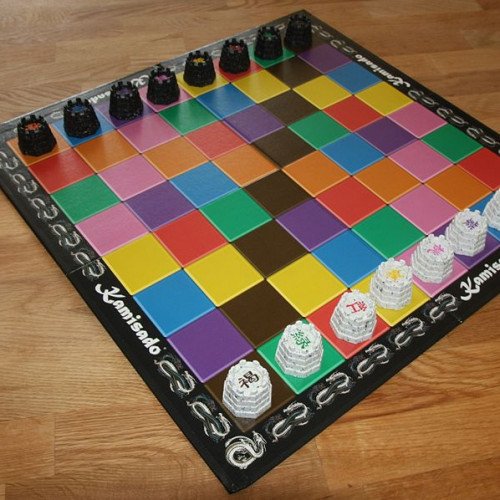KAMISADO VS XIANGQI

KAMISADO
Kamisado is an abstract strategy board game for two players that's played on an 8x8 multicoloured board. Each player controls a set of eight octagonal dragon tower pieces. Each player's set of dragon towers contains a tower to match each of the colours that appear on the squares of the board (i.e., a brown tower, a green tower, etc.). One player's towers have gold dragons mounted on the top, while the other player's towers are topped with black dragons. In an interview, designer Peter Burley said that the design of Kamisado dated back to a chance observation in a men's room in the 1970s. "I noticed that the floor had an interesting pattern of small colored tiles", he said. "I mentally made a note that this could possibly be used as a basis for a board game – this is something that I do quite a lot, whenever I see something a bit different. It must have made a deep impression on this occasion, however, because that night I had a vivid dream involving this tile pattern, and somehow the notion of 'whatever colour you land on, your opponent must move a piece that matches this'. I guess my subconscious mind had been working on this and sorted it out while I was asleep." The players’ towers start the game on the row nearest to them. The players take turns moving one tower any number of spaces in a straight line, either directly forwards or diagonally forwards, but not into or through a square already containing another dragon tower. The player with the black dragons moves first and may choose any tower. From this point onwards, each player must move the dragon tower that matches the colour of the square that the opponent's last move finished on. The object of the game is to reach your opponent's Home Row with one of your dragon towers. The first player to achieve this goal is the winner of the round. Games may be played as single rounds, or as more advanced ‘Match’ formats. Matches are played up to 3 points (Standard Match), 7 points (Long Match) or 15 points (Marathon Match). During a match, each time a round is won, a special ‘Sumo Ring’ is added to the dragon tower that has fought its way through to the opponent's Home Row. The sumo rings provide the scoring system for the game, and also endow special powers to the dragon towers that carry them. These towers are known as Sumo towers and have the ability to push opponent's towers back one space, by using a move known as a ‘Sumo Push’.
Statistics for this Xoptio

XIANGQI
Xiangqi (Chinese: 象棋; pinyin: xiàngqí; Wade–Giles: Hsiang ch'i; English: /ˈʃɑːŋtʃi/), also called Chinese chess or Elephant chess, is a strategy board game for two players. It is one of the most popular board games in China, and is in the same family as Western chess, chaturanga, shogi, Indian chess and janggi. Besides China and areas with significant ethnic Chinese communities, xiangqi is also a popular pastime in Vietnam, where it is known as cờ tướng. The game represents a battle between two armies, with the object of capturing the enemy's general (king). Distinctive features of xiangqi include the cannon (pao), which must jump to capture; a rule prohibiting the generals from facing each other directly; areas on the board called the river and palace, which restrict the movement of some pieces (but enhance that of others); and placement of the pieces on the intersections of the board lines, rather than within the squares. Xiangqi is played on a board nine lines wide and ten lines long. As in the game Go (圍碁; or Wei ch'i 圍棋), the pieces are placed on the intersections, which are known as points. The vertical lines are known as files (Chinese: 路; pinyin: lù; "road"), and the horizontal lines are known as ranks (Chinese: 線/綫; pinyin: xiàn; "line"). Centred at the first to third and eighth to tenth ranks of the board are two zones, each three points by three points, demarcated by two diagonal lines connecting opposite corners and intersecting at the centre point. Each of these areas is known as 宮 About this soundgōng, a castle. Dividing the two opposing sides, between the fifth and sixth ranks, is 河 hé, the "river". The river is often marked with the phrases 楚河 About this soundchǔ hé, meaning "River of the Chu ", and 漢界 About this soundhàn jiè, meaning "Border of the Han", a reference to the Chu–Han War. Although the river (or Hanchu boundary) provides a visual division between the two sides, only two pieces are affected by its presence: soldiers have an enhanced move after crossing the river, and elephants cannot cross it. The starting points of the soldiers and cannons are usually, but not always, marked with small crosses.